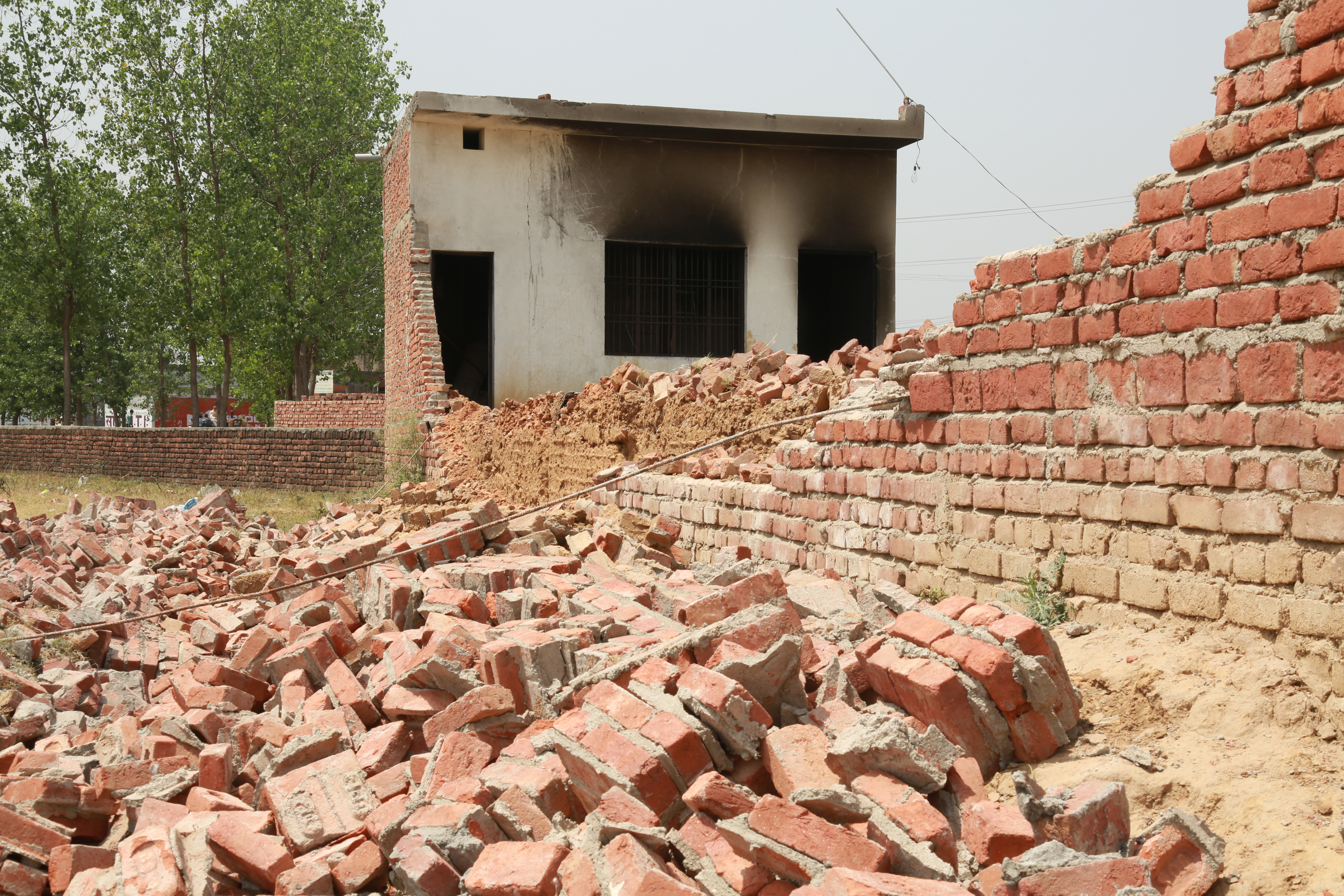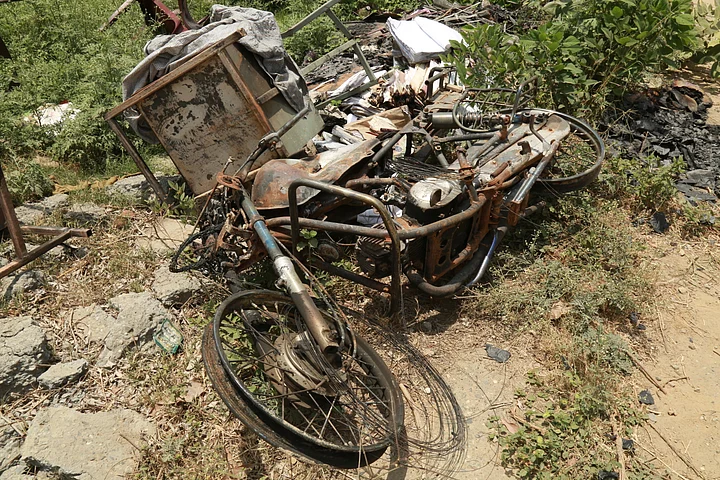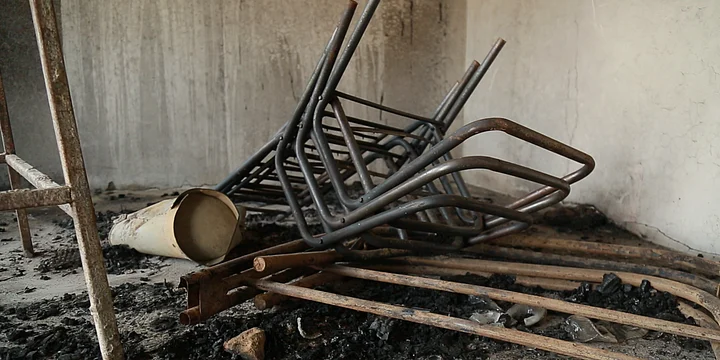The tension is palpable. The calm uneasy. Despite heavy security across Saharanpur, the mood among the Dalits and the Thakurs does not augur well.
Over the past month, peace in the district has been punctuated, time and again, with violence and unrest. It has been billed as the Yogi administration’s first major law and order challenge in UP, but what is fuelling Saharanpur’s caste conflict?
On 5 May, a Thakur rally commemorating Maharana Pratap sparked off violence as it passed through a Dalit neighbourhood in the village of Shabbirpur. The clashes between the two communities left one dead, at least 15 injured and 17 arrested. The other details differ depending on whom you speak to.
The Thakurs entered our village wielding swords and flashing guns. Accompanying the chants of ‘Maharana Pratap zindabad’ were slogans of ‘Ambedkar murdabad’ and ‘Ravidas murdabad’. They were shouting that the Dalits deserved to stay trodden upon. That our rightful place was under their feet.Parli, a Dalit woman in Shabbirpur
Inside her home, Parli shows us a torn poster of Ravidas lying on the ground. Two tempos are parked nearby, their windscreens shattered – all handiwork of the Thakur mob, she claims.
Less than a couple of hundred metres away, a string of houses lie gutted. One of them is razed to the ground and deserted. Neighbours inform that its residents are still in the hospital, injured from the clashes. When they do return, they will realise not much is left to call it home.
A few kilometres away, in the village of Rasoolpur, 75-year-old Biram Singh is sitting in the midst of a large group of Thakur men. Singh remembers the call he received on the evening of 5 May. “There was a fight in Shabbirpur, your son is injured”, he was told. On reaching the hospital, he found his 27-year-old son Sumit lying dead. Singh is mostly quiet. Grieving. Those around him, though, are enraged.
The Dalits burnt their own homes when they realised they had killed a Thakur. The arson was to cover up a murder.Ved Lal Singh, Sumit’s uncle
Vishal Pundir, a 24-year-old Thakur, argues “When a Dalit dies, the headlines read that a Dalit has died and an uproar follows. But when Sumit died, the papers only said one person has died in clashes.”
Kartikay Rana, son of former SP minister and Thakur leader Rajendra Rana, is also part of the gathering. Projecting himself as a protector of Thakur interests, Rana says he will sit on a hunger strike from 16 May if the state fails to get tough on Sumit’s case.
Meanwhile, Dalit leaders from nine states across the country have converged in western Uttar Pradesh to conduct a fact-finding mission into the Saharanpur violence. Among them is Jignesh Mewani, who had led the protests following the violence against Dalits in Una, Gujarat in 2016.
Through optics or otherwise, the conflict in Saharanpur seems here to stay. Especially with municipal polls due later this month.
The Rise of Ambedkar's Army
Though 17 people were arrested in relation to the violence in Shabbirpur on 5 May, both Dalits and Thakurs feel that the administration is letting them down. Each community alleges the state is biased in favour of the other.
The Thakurs did not have permission for the yatra on 5 May. Why were they allowed to proceed then? Police were clearly complicit. They desecrated the Ravidas temple, set Dalit homes ablaze. Demanding a serious probe, we gave the administration a deadline of two days. We asked them to tell us by the third day how far the probe had come. If not, we would agitate – for as long as it takes.Advocate Chandrashekhar Azad, Founder of the Bhim Army
Based out of his village of Chhutmalpur in Saharanpur, 29-year-old Chandrashekhar Azad helms a group of young Dalit volunteers. They call themselves the Bhim Army. It is an organisation that has come to play a key role in the region’s caste conflict since the clashes in Shabbirpur.
Founded only in July 2015, the Bhim Army has already caught the eye and ire of many in Uttar Pradesh.
On 9 May, the Bhim Army called for Dalits from across the district to assemble for a mahapanchayat. When police denied permission for the gathering, clashes erupted between the cops and Dalit protesters in ten different localities of Saharanpur. The Bhim Army alleges that the forces lathicharged and assaulted peaceful protesters.
In the hours that followed, Dalit mobs went on to burn down a police chowki in Ramnagar, numerous vehicles and a memorial for Maharana Pratap that was being built by the upper caste Thakurs. At least 11 police personnel and a sub-divisional magistrate were injured in stone-pelting.
- 01/03The under-construction memorial site for Maharana Pratap that was burned down (Photo: Abhay Sharma/The Quint)
- 02/03Outside the gutted police chowki in Ramnagar, a vehicle damaged in the arson (Photo: Abhay Sharma/The Quint)
- 03/03At the under-construction memorial site for Maharana Pratap that was burned down (Photo: Abhay Sharma/The Quint)

If police say we reacted with violence, tell me, why is that wrong? You beat us with your lathis, shoot at us. Even animals act in self-defence. We are but human.Vinay Ratan Singh, Co-Founder of the Bhim Army
Police say the investigation so far points to a clear involvement of the Bhim Army in the violence.
We have learnt that the Bhim Army was involved in the procession on 9 May. Their role in the unrest is being investigated. The information so far suggests that the group indulged in violence.Vidya Sagar Mishra, SP, Saharanpur (Rural)
Vidya Sagar Mishra was transferred from Agra to Saharanpur after 2 SPs got marching orders following the violence on 9 May. Yet the newly-appointed SP of Saharanpur (Rural) makes an interesting admission when asked if police had cracked down on peaceful protesters, like the Bhim Army claimed.
Asking whether the cops lathicharged first or the Dalits attacked them before is like questioning whether the chicken came first or the egg.Vidya Sagar Mishra
But Chandrashekhar says that he did his best to stop the violence. “How is it fair for those protesting peacefully to be beaten up by police? Yet, when I got a call from the district magistrate that the situation was getting out of hand, I immediately went with the DM and the SSP to seven or eight locations and asked the crowds to calm down.”
Within hours of speaking to The Quint on Wednesday, Chandrashekhar went underground, fearing a police crackdown.
On Monday, he released an audio message through a Facebook page calling Dalits to assemble at Delhi’s Jantar Mantar for a protest on 21 May. He assured his audience that his struggle was far from over.
Instead of calling me a Naxalite, remember that the Bhim Army raises the voice of the oppressed.
The Dalits of Saharanpur refer to the Bhim Army as an assertive Bahujan force taking on a casteist establishment. When asked about the violence they are accused of, Munish Devi, a Dalit woman in Shabbirpur says,
The Thakurs burnt down our houses. The Bhim Army’s violence is merely a spark from that fire. At a time when even the probes are biased against Dalits, the Bhim Army is supporting us. Standing up for us.
Munish’s neighbour Anita Devi asks, “Why just Bhim Army? The administration should level allegations of violence against the Thakurs who entered our homes and beat us up. Should we call it a conspiracy by the government then?”
The Bhim Army is as revered by the Dalits of the region as it is reviled by the Thakurs.
“It's a terrorist army that will burn the entire village if their demands aren't met”, says Ved Lal Singh. Some of the Thakurs chip in from behind, “They’re Naxalites.”
Mohan Singh says the violence on 9 May has exposed the true face of the Bhim Army across the state. “They are definitely acting like terrorists.”
In Ramnagar, one of the locations where Dalit mobs went on a rampage on 9 May, locals are displeased with what they call the Bhim Army’s way of functioning.
Vinish Kumar runs a general store in Ramnagar. On the morning of the 9th, as a mob approached, Kumar shut shop and rushed home.
“Bhim Army’s idea of taking revenge by harassing the common man is wrong. This deepens the caste divide instead of reducing it. Their methods are wrong, violence isn’t the answer. They burnt more than a dozen vehicles and attacked journalists. They even attacked the gates of the residential complex I stay in.”
Jitender Kumar Chopra, 72, is a security guard at the Sun City residential complex where Vinish stays. “The mob pelted stones, shattered the windows of my post and broke this door. They threw stones at houses that were close to the road as well. Why damage private property? What have the people here done to them?”
The Politics of Rioting
Saharanpur is slated to host its civic body elections later this month. The timing of the repeated clashes, in the weeks running up to the polls, has therefore raised eyebrows.
Munish Devi, a Dalit woman in Shabbirpur, says inter-caste violence is not the norm in Saharanpur. “With mutual cooperation, the Shivratris of the upper castes and our Ravidas Jayantis always passed off peacefully. But recently, people coming in from outside have been fostering unrest between the Thakurs and the Dalits.”
She further alleges, “It is the BJP that is engineering these riots to consolidate its Thakur votebank before the local polls.”
Kartikay Rana calls himself a samaj sevak who is not in politics, yet admits a proximity to the Samajwadi Party. Rana claims the recent violence in the district is a last-ditch effort by the BSP to defend its dwindling Dalit voter base.
Though a former BSP stronghold, both Assembly seats in Saharanpur were won by the SP-Congress alliance in the recent state elections.
“The caste riots are part of the political repercussions of the mandate against the BSP. The party is now retaliating, using the Bhim Army to execute its agenda as a proxy organisation. Like the BJP has the Bajrang Dal, the BSP now has the Bhim Army.”
The Congress has demanded a judicial enquiry into the Saharanpur violence after the party’s Rajya Sabha MP PL Punia visited the district.
Speaking to The Quint, Punia, a former chairperson of the National Commission for Scheduled Castes, claimed that police are acting in a partisan manner against the Dalits.
The violence and atrocities against Dalits in Saharanpur is happening with the support of police. Take for example the death of Sumit Singh. Though reports say that the post-mortem indicates suffocation, police have been conclusively saying that he died due to violence. This is an unfair attempt to pin the blame on the Dalits. A judicial enquiry is the only way forward.
Punia adds, “The entire episode is a political charade by the local BJP MP Raghav Lakhanpal. PM Modi talks of honouring Ambedkar but his party acts against the interests of Dalits.”
Kicking up a Storm
On 20 April, Saharanpur witnessed violence between Hindus and Muslims. At the centre of the unrest was the local BJP MP Raghav Lakhanpal.
Despite being denied police permission, Lakhanpal had led a “Shobha Yatra” through the communally-sensitive village of Sadak Dudhli.
The yatra claimed to be in honour of Dr BR Ambedkar. Yet, most Dalits of the region had reportedly not been keen on joining Lakhanpal’s rally as they had observed Ambedkar Jayanti on 14 April in a ceremony of their own, and were suspicious of the BJP MP’s motives for the procession.
The reservations of the police and the misgivings of the Dalits were proved to not be unfounded when the yatra did lead to communal clashes in Sadak Dudhli on 20 April.
Additionally, Lakhanpal and his supporters marched to Saharanpur SSP Love Kumar’s official residence and pelted stones in protest against police denying permission for the rally. The mob also destroyed a CCTV camera and removed the nameplate outside his door.
Lakhanpal, his brother Rahul, BJP MLA from Deoband Brajesh SIngh and several others were booked on charges of instigating the mob to engage in violence and destruction of public property.
Yet, instead of action against its own MP, the state administration sent marching orders to SSP Love Kumar. He was transferred to Noida.
Is There an End in Sight?
In March 2016, a signboard with the words ‘The Great Chamar’ painted on it had caused quite a controversy in the village of Gharkoli. The signboard put up by some Dalits had been defaced by the upper castes in the village. Further, a statue of Ambedkar was smeared with black paint. As Dalits and Rajputs clashed, the Bhim Army made its entry into Gharkoli.
It has been a little over a year since the flashpoint in Gharkoli. But the legend has travelled across Saharanpur. As we passed Ramnagar, we found an identical signboard titled ‘The Great Chamar’ propped up proudly on the roof of a building. Next to it, a blue flag was waving in the wind – a blue ‘Bhim Army’ flag.
As the Dalit force asserts itself growing in strength and support (Chandrashekhar claims the Army has volunteers in seven states across north India) and clashing with an ever-belligerent Thakur community, violence seems just a rally away. In poll season, the brink is where they rest.
The question is, will our politicians tip them over? Or help hold the uneasy peace?
(This story is being republished from The Quint’s archives in the context of Bhim Army chief Chandrashekhar’s arrest on Thursday. It was originally published on 16 May 2017.)



